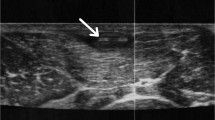Abstract
Subcutaneous human dirofilariasis is caused by the zoonotic filariae Dirofilaria repens. The frequency of reports is increasing in literature during the last few years and is considered by some authors as an emerging zoonosis. Here we report 21 cases of subcutaneous dirofilariasis, which were encountered over a period of 8 years. None of these cases were associated with peripheral eosinophilia. Since these lesions can mimic benign and malignant tumors, it is important to consider this as a differential diagnosis of subcutaneous nodules especially in an endemic area. In this report we would like to emphasize the importance of studying multiple deeper levels in suspected cases of parasitic granuloma to demonstrate the parasite.


Similar content being viewed by others
References
Dissanaike AS, De Abeyewickreme WS, Wijesundera M et al (1997) Human dirofilariasis caused by Dirofilaria (nochtiella) repens in Sri Lanka. Parassitologia 39:375–382
Favia G, Lanfrancotti A, della Torre A et al (1998) Advances in the identification of Dirofilaria repens and Dirofilaria imitis by a PCR-based approach. Parassitologia 40:401–402
Gautam V, Rustagi IM, Singh S et al (2002) Subconjunctival infection with Dirofilaria repens. Jpn J Infect Dis 52:47–48
Munro A, Genchi C, Cordero M, Simon F (1999) Human dirofilariasis in the European Union. Parasitol Today 15:386–389
Nadgir S, Tallur SS, Mangoli V et al (2001) Sunconjunctival dirofilariasis in India. Southeast Asian J Trop Med Public Health 32(2):244–246
Orihel TC (1969) Dirofilaria corynodes (Linstow, 1899): morphology and life history. J Parasitol 55:94–103
Pampiglione S, Canestri Trotti G, Rivasi F (1995) Human Dirofilariasis due to Dirofilaria (nochtiella) repens; a review of world literature. Parassitologia 37:149–193
Pampiglione S, Rivasi F, Angeli G et al (2001) Dirofilariasis due to Dirofilaria repens in Italy, an emergent zoonosis: report of 60 new cases. Histopathology 38:34–354
Ratnatunga N, Wijesundera MS (1999) Histopathological diagnosis of subcutaneous Dirofilaria repens infection in humans. Southeast Asian J Trop Med Public Health 30:375–378
Sabu L, Devada K, Subramanian H (2005) Dirofilariosis in dogs and humans in Kerala. Indian J Med Res 121:691–693
Sekhar HS, Srinivas H, Battu R et al (2000) Human ocular dirofilariasis in Kerala, Southern India. Indian J Pathol Microbiol 43:77–79
Senthivel K, Pillai KM (1999) A case of subcutaneous dirofilariasis in a woman in Kerala. Indian Vet J 76:263–264
Acknowledgments
We the authors are thankful to the Secretary and Dean of our institution for permitting us to publish this paper. We are also thankful to all the staff members of the various surgical departments for providing the material for this study
Conflict of interest
None to declare.
Author information
Authors and Affiliations
Corresponding author
Rights and permissions
About this article
Cite this article
Joseph, E., Matthai, A., Abraham, L.K. et al. Subcutaneous human dirofilariasis. J Parasit Dis 35, 140–143 (2011). https://doi.org/10.1007/s12639-011-0039-2
Received:
Accepted:
Published:
Issue Date:
DOI: https://doi.org/10.1007/s12639-011-0039-2




